Regulation of facilitative glucose transporters and AKT/MAPK/PRKAA signaling via estradiol and progesterone in the mouse uterine epithelium
- PMID: 19208550
- PMCID: PMC3093992
- DOI: 10.1095/biolreprod.108.072629
Regulation of facilitative glucose transporters and AKT/MAPK/PRKAA signaling via estradiol and progesterone in the mouse uterine epithelium
Abstract
Adequate uterine glucose metabolism is an essential part of embryo implantation and the development of an adequate utero-fetal environment. However, expression of facilitative glucose transporters (GLUTs [solute transporter family SLC2A]) and AKT/MAPK/PRKAA (PRKAA) signaling has not been described in the mouse uterine cells, to our knowledge. The objective of this study was to determine the hormonal regulation of SLC2A protein expression and AKT/MAPK/PRKAA signaling in the mouse uterine epithelial cells during estrous cycles and peri-implantation periods. SLC2As 1, 4, 8, and 9B were highly expressed in the luminal and glandular epithelia of estrous stage. In metestrous and diestrous stages, expression of SLC2As 1, 4, 8, and 9B was lower than that in proestrous stage. Levels of activated phospho-AKT (p-AKT), p-MAPK3, and p-MAPK1 also varied during the estrous cycle. Estrogen and progesterone injection in an ovariectomized mouse (delayed implantation model) resulted in a decrease and an increase, respectively, in expression of GLUTs in the luminal epithelial cells of the uterus. The expression of SLC2A1, SLC2A8, SLC2A9B, p-AKT, p-MAPK3/1, and p-PRKAA was increased in the decidual region of the implantation sites and was significantly increased in the uterus of activated implantation. Using an artificial decidualization mouse model, it was also demonstrated that expression of the same GLUTs, p-MAPK3/1, and p-PRKAA was dramatically higher in the decidualized uteri than that in the control uteri. These results suggest that steroid hormones regulate expression of uterine epithelial GLUTs possibly through AKT/MAPK/PRKAA signaling pathways and that glucose utilization may have an important role in decidualization and possibly in the maintenance of pregnancy.
Figures
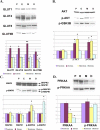
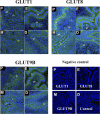
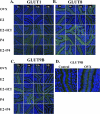
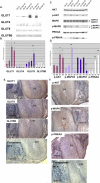
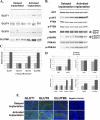
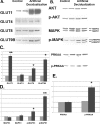
Similar articles
-
Fructose Synthesis and Transport at the Uterine-Placental Interface of Pigs: Cell-Specific Localization of SLC2A5, SLC2A8, and Components of the Polyol Pathway.Biol Reprod. 2016 Nov;95(5):108. doi: 10.1095/biolreprod.116.142174. Epub 2016 Aug 17. Biol Reprod. 2016. PMID: 27535960
-
Select nutrients in the ovine uterine lumen. ii. glucose transporters in the uterus and peri-implantation conceptuses.Biol Reprod. 2009 Jan;80(1):94-104. doi: 10.1095/biolreprod.108.071654. Epub 2008 Aug 27. Biol Reprod. 2009. PMID: 18753604
-
Studies using the estrogen receptor alpha knockout uterus demonstrate that implantation but not decidualization-associated signaling is estrogen dependent.Biol Reprod. 2002 Oct;67(4):1268-77. doi: 10.1095/biolreprod67.4.1268. Biol Reprod. 2002. PMID: 12297545
-
Interferons and progesterone for establishment and maintenance of pregnancy: interactions among novel cell signaling pathways.Reprod Biol. 2008 Nov;8(3):179-211. doi: 10.1016/s1642-431x(12)60012-6. Reprod Biol. 2008. PMID: 19092983 Review.
-
Progesterone receptor signaling in the initiation of pregnancy and preservation of a healthy uterus.Int J Dev Biol. 2014;58(2-4):95-106. doi: 10.1387/ijdb.140069mw. Int J Dev Biol. 2014. PMID: 25023675 Free PMC article. Review.
Cited by
-
Progesterone increases metabolism via the pentose phosphate pathway in bovine uterine epithelial cells.Mol Biol Rep. 2024 Oct 19;51(1):1076. doi: 10.1007/s11033-024-10001-0. Mol Biol Rep. 2024. PMID: 39425753 Free PMC article.
-
Glucose transporter 1 is important for the glycolytic metabolism of human endometrial stromal cells in hypoxic environment.Heliyon. 2020 Jun 8;6(6):e03985. doi: 10.1016/j.heliyon.2020.e03985. eCollection 2020 Jun. Heliyon. 2020. PMID: 32548315 Free PMC article.
-
Asymmetric syncytial expression of GLUT9 splice variants in human term placenta and alterations in diabetic pregnancies.Reprod Sci. 2011 Jan;18(1):20-7. doi: 10.1177/1933719110380276. Epub 2010 Oct 6. Reprod Sci. 2011. PMID: 20926839 Free PMC article.
-
Slc2a8 deficiency in mice results in reproductive and growth impairments.Biol Reprod. 2012 Aug 30;87(2):49. doi: 10.1095/biolreprod.111.097675. Print 2012 Aug. Biol Reprod. 2012. PMID: 22649075 Free PMC article.
-
Endometrial microbiome at the time of embryo transfer: next-generation sequencing of the 16S ribosomal subunit.J Assist Reprod Genet. 2016 Jan;33(1):129-36. doi: 10.1007/s10815-015-0614-z. Epub 2015 Nov 7. J Assist Reprod Genet. 2016. PMID: 26547201 Free PMC article.
References
-
- Joost HG, Bell GI, Best JD, Birnbaum MJ, Charron MJ, Chen YT, Doege H, James DE, Lodish HF, Moley KH, Moley JF, Mueckler M, et al. Nomenclature of the GLUT/SLC2A family of sugar/polyol transport facilitators. Am J Physiol Endocrinol Metab 2002; 282: E974 E976 - PubMed
-
- Joost HG, Thorens B. The extended GLUT-family of sugar/polyol transport facilitators: nomenclature, sequence characteristics, and potential function of its novel members (review). Mol Membr Biol 2001; 18: 247 256 - PubMed
-
- Wood IS, Trayhurn P. Glucose transporters (GLUT and SGLT): expanded families of sugar transport proteins. Br J Nutr 2003; 89: 3 9 - PubMed
-
- Riley JK, Moley KH. Glucose utilization and the PI3-K pathway: mechanisms for cell survival in preimplantation embryos. Reproduction 2006; 131: 823 835 - PubMed
-
- Mueckler M. Family of glucose-transporter genes: implications for glucose homeostasis and diabetes. Diabetes 1990; 39: 6 11 - PubMed
Publication types
MeSH terms
Substances
Grants and funding
LinkOut - more resources
Full Text Sources
Miscellaneous

